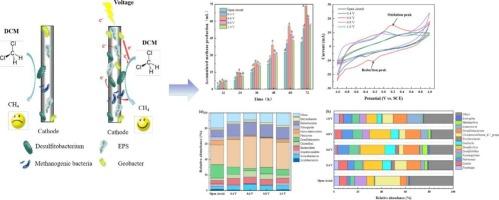Facilitation of dichloromethane biodegradation by different voltages in microbial electrolysis cell
IF 6.7
2区 工程技术
Q1 ENGINEERING, CHEMICAL
引用次数: 0
Abstract
Dichloromethane (DCM), a recalcitrant chlorinated volatile organic compound (Cl-VOC), poses significant environmental and health risks. This study systematically investigated the effect of different voltages on the biodegradation of DCM in microbial electrolysis cells (MECs). The results demonstrated that 0.6 V maximized DCM removal (89.59 %) and methane yield (54.03 mL), correlating with a 42.7 % reduction in total organic carbon. Cyclic voltammetry revealed optimal electron transfer efficiency at 0.6 V (CV integral area: 27.86 mA*V), indicating enhanced redox reversibility. Biofilm characterization showed peak extracellular polymeric substance (EPS) secretion and zeta potential elevation (121.6 %), facilitating pollutant adsorption and extracellular electron transfer. Microbial community analysis identified enriched electroactive (Geobacter, Desulfovibrio) and dechlorinating bacteria (Desulfitobacterium) at 0.6 V, driving reductive dechlorination. This study optimized the mineralization of DCM through voltage-synergistic biofilm electroactivity and microbial community structure, thereby providing a strategic approach to enhance the degradation of DCM in MECs.

不同电压对微生物电解池中二氯甲烷生物降解的促进作用
二氯甲烷(DCM)是一种顽固的氯化挥发性有机化合物(Cl-VOC),具有重大的环境和健康风险。本研究系统地研究了不同电压对微生物电解细胞(MECs)中DCM生物降解的影响。结果表明,0.6 V时DCM去除率最高(89.59%),甲烷产率最高(54.03 mL),总有机碳减少42.7%。循环伏安法显示,0.6 V (CV积分面积:27.86 mA*V)时电子传递效率最高,表明氧化还原可逆性增强。生物膜表征显示胞外聚合物(EPS)分泌峰值和zeta电位升高(121.6%),有利于污染物吸附和胞外电子转移。微生物群落分析发现,在0.6 V下,富电活性菌(Geobacter, Desulfovibrio)和脱氯菌(Desulfitobacterium)驱动还原性脱氯。本研究通过电压协同生物膜电活性和微生物群落结构优化了DCM的矿化,从而为提高mec中DCM的降解提供了策略途径。
本文章由计算机程序翻译,如有差异,请以英文原文为准。
求助全文
约1分钟内获得全文
求助全文
来源期刊

Journal of water process engineering
Biochemistry, Genetics and Molecular Biology-Biotechnology
CiteScore
10.70
自引率
8.60%
发文量
846
审稿时长
24 days
期刊介绍:
The Journal of Water Process Engineering aims to publish refereed, high-quality research papers with significant novelty and impact in all areas of the engineering of water and wastewater processing . Papers on advanced and novel treatment processes and technologies are particularly welcome. The Journal considers papers in areas such as nanotechnology and biotechnology applications in water, novel oxidation and separation processes, membrane processes (except those for desalination) , catalytic processes for the removal of water contaminants, sustainable processes, water reuse and recycling, water use and wastewater minimization, integrated/hybrid technology, process modeling of water treatment and novel treatment processes. Submissions on the subject of adsorbents, including standard measurements of adsorption kinetics and equilibrium will only be considered if there is a genuine case for novelty and contribution, for example highly novel, sustainable adsorbents and their use: papers on activated carbon-type materials derived from natural matter, or surfactant-modified clays and related minerals, would not fulfil this criterion. The Journal particularly welcomes contributions involving environmentally, economically and socially sustainable technology for water treatment, including those which are energy-efficient, with minimal or no chemical consumption, and capable of water recycling and reuse that minimizes the direct disposal of wastewater to the aquatic environment. Papers that describe novel ideas for solving issues related to water quality and availability are also welcome, as are those that show the transfer of techniques from other disciplines. The Journal will consider papers dealing with processes for various water matrices including drinking water (except desalination), domestic, urban and industrial wastewaters, in addition to their residues. It is expected that the journal will be of particular relevance to chemical and process engineers working in the field. The Journal welcomes Full Text papers, Short Communications, State-of-the-Art Reviews and Letters to Editors and Case Studies
 求助内容:
求助内容: 应助结果提醒方式:
应助结果提醒方式:


